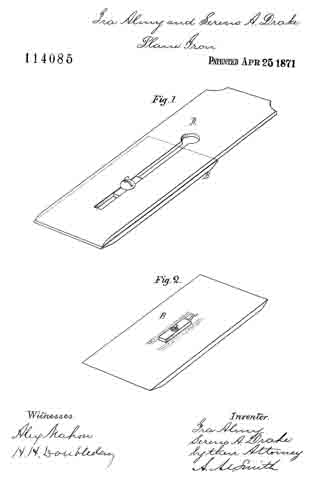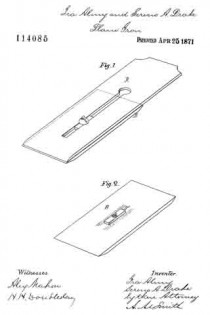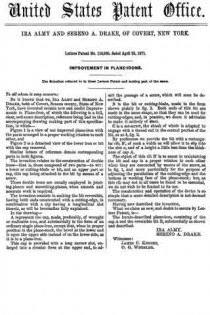
| PLEASE NOTE: The images presented on this page are of low resolution and, as a result, will not print out very well. If you wish to have higher resolution files then you may purchase them for only $2.95 per patent by using the "Buy Now" button below. All purchases are via PayPal. These files have all been cleaned up and digitally enhanced and are therefore suitable for printing, publication or framing. Each zip package contains all the images below (some packages may contain more), and purchased files can be downloaded immediately. |
United States Patent Office.
IRA ALMY AND SERENO A. DRAKE, OF COVERT, NEW YORK.
Letters Patent No. 114,085, dated April 25, 1871.
_________________
IMPROVEMENT IN PLANE-lRONS.
_________________
The Schedule referred to in these Letters Patent and making part of the same.
_________________
To all whom it may concern:
Be it known that we, IRA ALMY and SERENO A. DRAKE, both of Covert, Seneca county, State of New York, have invented certain new and useful Improvements in Plane-Iron, of which the following is a full, clear, and exact description, reference being had to the accompanying drawing making part of this specification, in which —
Figure 1 is a view of our improved plane-iron with the parts arranged in a proper working relation to each other, and Figure 2 is a detached view of the lower iron or bit with the cap removed.
Similar letters of reference denote corresponding parts in both figures.
The invention relates to the construction of double irons — that is, those composed of two parts — to wit: a lower or cutting~blade or bit, and an upper part or cap, this cap being attached to the bit by means of a screw.
These double irons are usually employed in jointing-planes and srnoothing-planes, when smooth and accurate work is required.
The invention consists in making the bit reversible, having both ends constructed with a cutting-edge, in combination with a cap having a longitudinal slot therein, as will be hereinafter fully explained.
In the drawing —
A represents the cap, made, preferably, of wrought or malleable iron, and substantially in the form of an ordinary single plane-iron, except that, when in proper position in the plane-stock, the bevel at the lower end is upon the upper side instead of on the lower side, as it is in a plane-iron.
This cap is provided with a long narrow slot, enlarged into a circular form at the upper end, to admit the passage of a screw, which will soon be described.
B is the bit or cutting-blade, made in the form shown plainly in fig. 2. Both ends of this bit are made in the same shape, so that they can be used for cutting-edges, and, in practice, we deem it advisable to make it entirely of steel.
C is a set-screw, the shank of which is adapted to engage with a thread cut in the central portion of the bit, as at b, fig. 2.
By preference we provide the bit with a rectangular rib, B’, of such a width as will allow it to slip into the slot c, and of a height a little less than the thickness of cap A.
The object of this rib B’ is to assist in maintaining the bit and cap in a proper relation to each other when they are connected by means of the screw, as in fig. 1, and more particularly for the purpose of adjusting the parallelism of the cutting-edge and the bottom or working face of the plane-stock; but, as this rib may not in all eases be found to he essential, we do not wish to be limited to its use.
The construction and operation of the device is so simple that a more detailed description is not deemed necessary.
Having now described the invention, What we claim as new, and desire to secure by Letters Patent, is —
The herein-described plane-iron, consisting of the cap A and the reversible bit B, substantially as shown and described.
IRA ALMY.
SERENO A. DRAKE.
Witnesses:
JAMES C. KNIGHT,
O. G. WHEELER.


